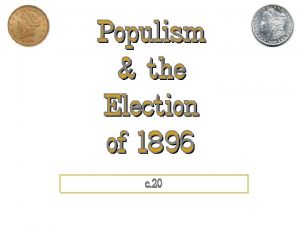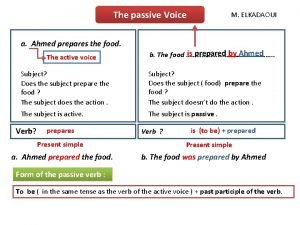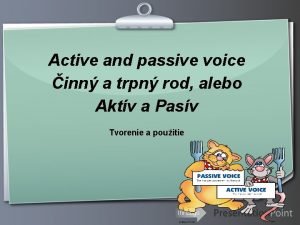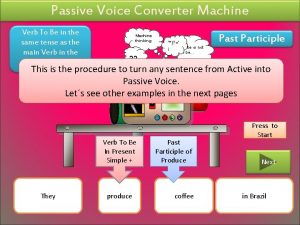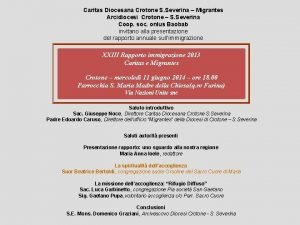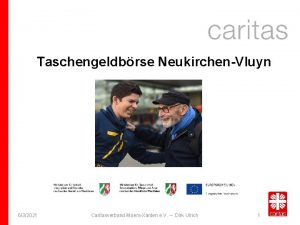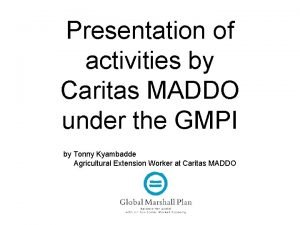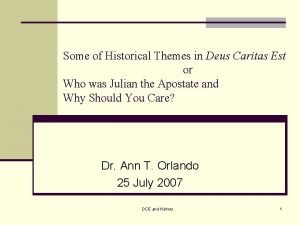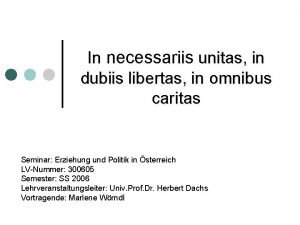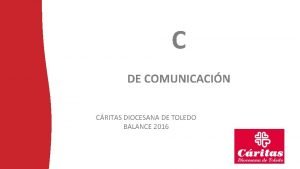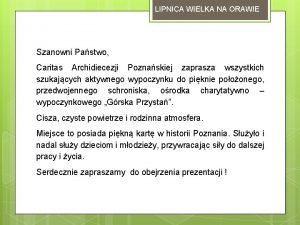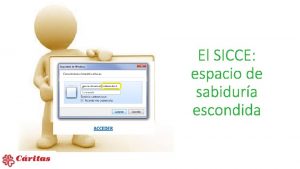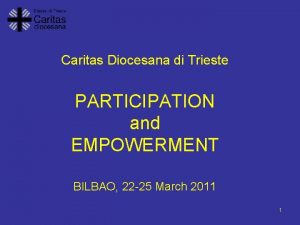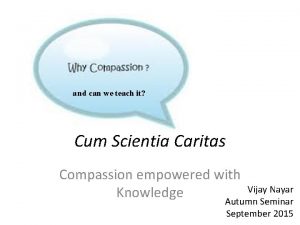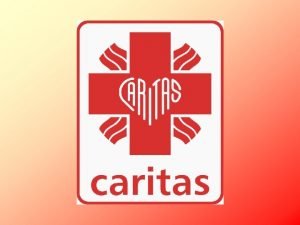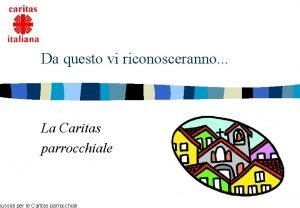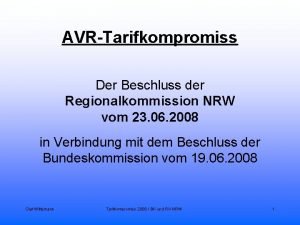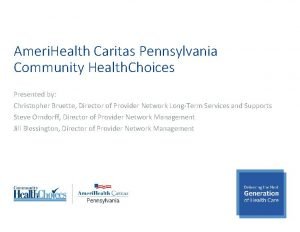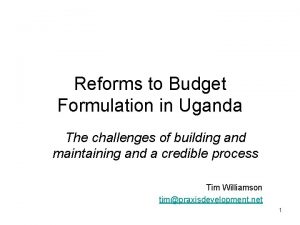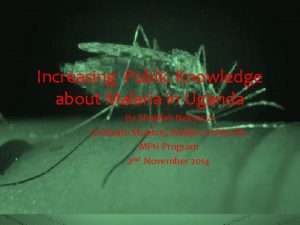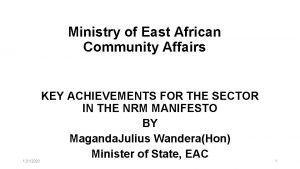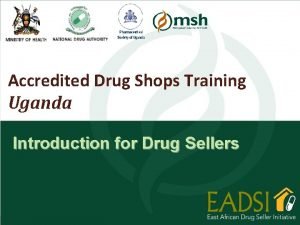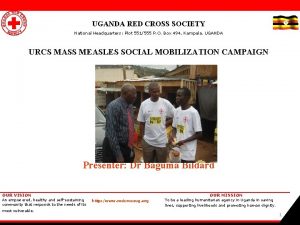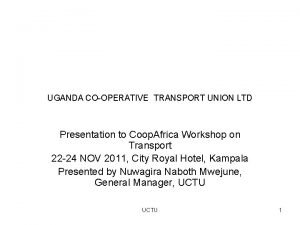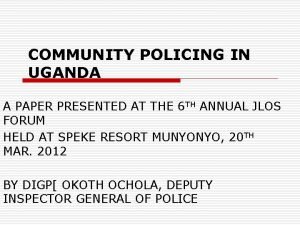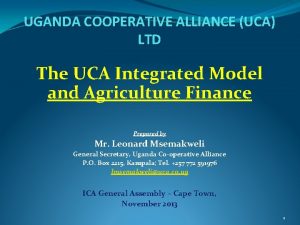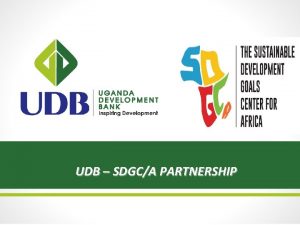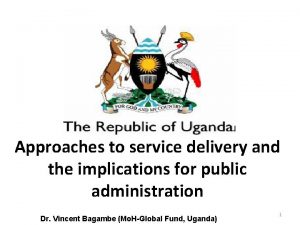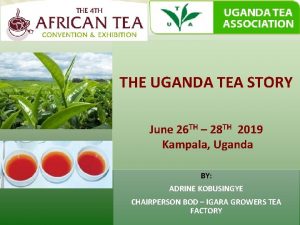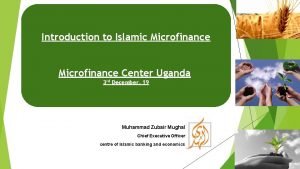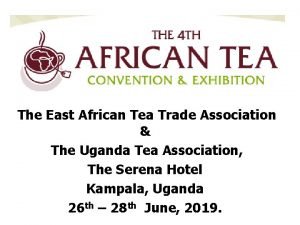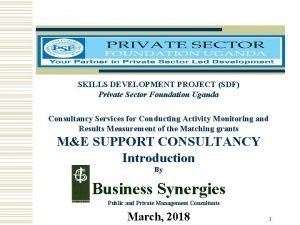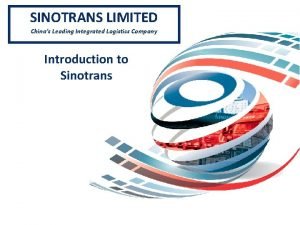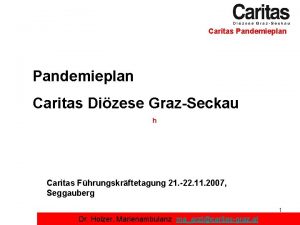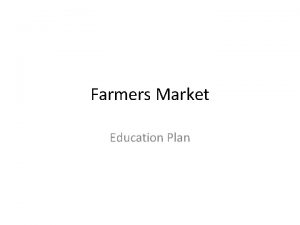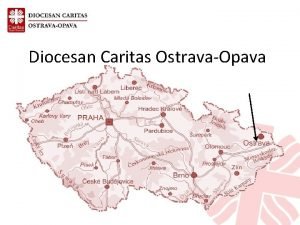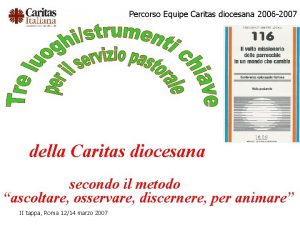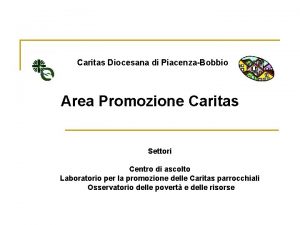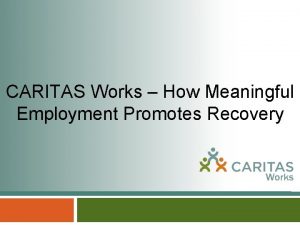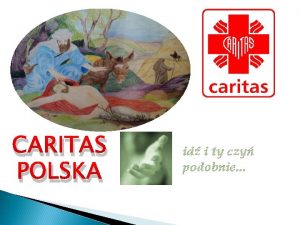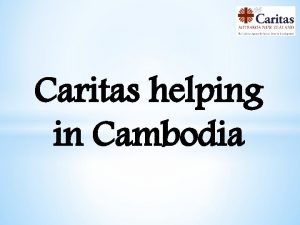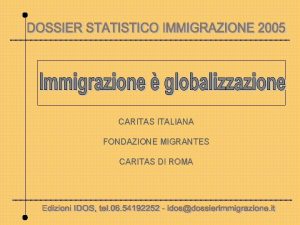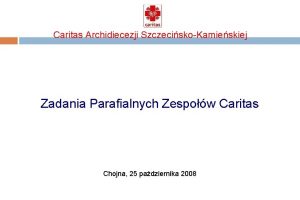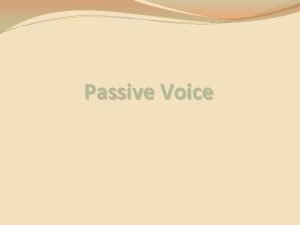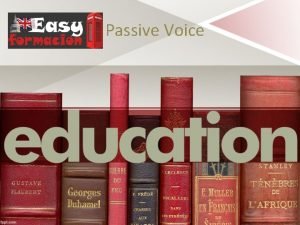CARITAS UGANDA CU THE UGANDA FARMERS COMMON VOICE





























































- Slides: 61

CARITAS UGANDA (CU) THE UGANDA FARMERS’ COMMON VOICE PLATFORM (UFCVP) A STUDY TO ASSESS THE VALUE FOR MONEY AND IMPACT OF SELECTED GOVERNMENT PROGRAMMES ON SMALL HOLDER FARMERS (OPERATION WEALTH CREATION, YOUTH LIVELIHOOD PROGRAMME AND COMMUNITY AGRICULTURAL INFRASTRUCTURE IMPROVEMENT PROGRAMME). DRAFT REPORT By July 27, 2016 1

Presenters 1. Mr. Andrew Ainebyona- Lead Consultant 2. Mr. Joseph Kayuza - Development Planning and Management Consultant. 2

Presentation Outline w Background to the study w Approach and Methodology w Study Findings w General Conclusions w Recommendations for Improvement. 3

Background to the Study (Introduction) w Importance of Agriculture in Uganda’s economy n n n 25. 3% of the country‘s GDP 72% of the total labour force Over 40% of export earnings w Policies for Agricultural development n n n Generated by the mainstream MAAIF - SIP Political pronouncements , orders and directives – improve financing Mixed implementation results w CU thru UFCVP - Review n n Value for money - Farmers and youth benefit OWC, YLP and CAIIP 4

Background to the Study (Objectives) w The overall objective n Assess the value for money and impact of OWC, YLP and CAIIP w Specific Objectives n n n Assess processes and procedures to meet set targets Comparative analysis for best practices. Gender dynamics - access, benefits and impact Establish factors that influence access and utilization of the programmes. Recommendations for improvement 5

Approach and Methodology w Geographical Area w Study population - categories w Design and Sample selection w Data collection techniques w Data Processing and Management 6

Approach and Methodology Geographical area w Four regions n East – Soroti, Mbale, Bulambuli and Kamuli n West – Kisoro, Ntungamo, Bushenyi and Kabarole n North – Lira, Kole, Gulu and Nebbi n Central – Masaka, Mityana, Luwero and Mukono w Each selected District-two sub counties 7

Approach and Methodology (Population Category) w Direct Beneficiaries of (OWC, YLP, CAIIP) w Programme staff n n Central level l National Programme Facilitator CAIIP l Executive Director NAADS/MAAIF l Coordinators of OWC. LG level – l Political leaders, CAOs, Production Officers, CDOs, Sub-county Chiefs, District Coordinators and focal persons 8

Approach and Methodology (Design and Sample Selection) w Study design - Cross sectional survey w Triangulation of findings n n n Primary and secondary sources. Interviewer administered questionnaires Observations and case study profiling - the impact on the target groups w Multi-stage Probability Proportional to Size (PPS) sampling - the women, men and youth beneficiary respondents. 9

Approach and Methodology (Design and Sample Selection cont. ) w Raosoft sampling technique - 95% confidence level. w Quantitative sample - increased by 10% to give 426 respondents. w Qualitative sample: 517 respondents - 32 FGD respondents, 20 KII respondents, and 2 case study respondents w Equal representation: Region – 16 districts , 4 per region; District – 32 sub counties, 2 per district; sub-county level. - random selection of household respondents w YLP – CDOs directed the team to beneficiary respondents w OWC and CAIIP – HH respondents - randomly selected and interviewed. 10

Approach and Methodology (Data Collection Tools/Techniques) w Data collection techniques: n Quantitative data-Individual/household interviews other quasiquantitative data from secondary sources. w Key informant interviews (using checklists) n Program staff, youth groups/associations leaders, district and sub county technical staff, and political and administrative leaders. w Focus group discussions (using FGD guide) n Smallholder farmers and youth beneficiaries w Review of secondary data sources n Ministry documents, programme documents and others w Observation of farming practices, agricultural enterprises, livelihood activities, and CAIIP infrastructure - bulking centers, markets and roads. 11

Approach and Methodology (Data Processing and Management) w Quantitative data: n n n filled questionnaires were entered using the SPSS, Frequencies and cross-tabulations run Relevant summary statistics described and interpreted to derive findings w Qualitative data: n n n Field notes of KIIs and FGDs transliterate to form texts for objective specific analysis. Transcripts reviewed to explain aspects relevant to study objectives Analysis of interviews/discussions - the key quotations, insights, and explanations from the transcripts. w Data limitations: none beneficiaries not captured, some KIs 12 concealed vital information on value for money.

Study Findings (Social Demographic Characteristics) w The designs of the programs emphasize gender equity but at the time of the study more men than women were accessing the programmes. w The selection of the respondents for YLP and OWC was based on whether one was a beneficiary or not, but the majority of the respondents in all the three programs were male. n (OWC – 64% , YLP – 74% and CAIIP – 52%) 13

Study Findings (Social Demographic Characteristics cont. ) w Agriculture or farming is not the main occupation of the beneficiaries of OWC, most (64%) are salaried earners - teachers and other professions, n n n Information about the programme Can meet the requirements for accessing the programme - having enough land, some money to pay for casual labor to prepare land, plant, harvest or look after the animals. Inefficiencies in utilization of agricultural inputs supplied: they do not primarily depend on agriculture as their main source of income, they pay little attention. w The poor peasant farmer who depends on agriculture fully is therefore not benefiting from the programme. 14

Study Findings (Social Demographic Characteristics cont. ) w Majority of the respondents had secondary or higher level education w OWC – 57% , YLP – 77% and CAIIP – 47%. w Easy for them to access information on the programmes and receive training relevant. 15

Study Findings (OWC) w OWC Overview w Requirements for Accessing OWC w Implementation Performance w Gender Perspective w Implementation Challenges w Proposals for Improving OWP 16

Study Findings (OWC) (Overview) w OWC Objectives n n n Mobilize the masses to engage in commercial agricultural activities to boost their household incomes Distribute production inputs equitably and timely to boost production and productivity at household level Facilitate rural technological upgrading to allow smallholder farmers to transform themselves into small-scale industrialists Stimulate local and community enterprise development across the country Facilitate infrastructure development particularly in rural areas 17

Study Findings (OWC) (Overview cont. ) w Focus of OWC n Distribution of farm inputs - planting and breeding materials and machinery, n Provision of single spine extension services, n Improvement of post-harvest handling storage, n Value addition to enhance household incomes, food security and agricultural transformation. 18

Study Findings (OWC) (Requirements for Accessing OWC) w The OWC Standing Orders of Procedure (SOP) - spell out criteria for selection of beneficiaries n n Identified at the village level Screened by sub-county LG forwarded to district team approves. beneficiary's interest, availability of enough land demonstrated readiness. w Corruption tendencies at village, LLG and HLG levels n n Selection of beneficiaries Distribution of inputs. 19

Study Findings (OWC) (Implementation Performance) w Three levels of oversight, coordination, planning, supervision, monitoring, evaluation and validation n The National level - senior Presidential Advisor on Defense and Security, Regional/Zonal level headed by Zonal Coordinators Constituency Structure headed by Constituency Coordinators - UPDF officers w The three structure for coordination and oversight under is adequate and effective. It provides for collaboration with relevant agencies at national and Local Government levels. 20

Study Findings (OWC) (Implementation Performance cont. ) w UPDF was not technically placed to offer extension services, but had played a key role in ensuring that logistics of moving farm inputs to various destinations was achieved regardless of budgetary constraints. n n As a result overall, OWC has met some of the targets on specific inputs to farmers and sometimes exceeding the targets It is only in crop production and livestock production, where some training has been done and even here only a small percentage of the respondents 13. 5% and 9% respectively. 21

Study Findings (OWC) (Implementation Performance cont. ) w There are challenges related to accessibility to inputs (improved seeds) n n n Related to the amounts being distributed, not all who want the seeds actually get them. 92% of respondents indicated that availability of improved seeds had improved but only 75% affirm that they are accessible Over 80% of respondents affirmed difficulties in accessing pesticides/ herbicides, inorganic fertilisers farm equipment and improved beekeeping technology. 22

Study Findings (Implementation Performance cont. ) w In some instances selection of beneficiaries did not take into account their interests and hence utilisation of inputs was not optimal. n Poor program performance was evident where there was poor beneficiary selection, poor quality of inputs or where the inputs were delivered late. w Unlike when the programme started there is a tendency for top-down planning being espoused as opposed to bottom-up planning. n efforts are being put on cash crops and some other area specific enterprises - the communities feel their needs are not met by the programme 23

Study Findings (OWC) (Gender Perspective) w Men continue to dominate OWC as implementers and beneficiaries n n Government requires people who have land to operate agriculture activities and land is owned by men The program only considers only widows who are household heads Because of Illiteracy women are not participating in the program and have left it for men to participate Women fear to take heifers - source of disagreements and domestic violence with regard to sharing the proceeds of milk and cattle sales with their spouses, 24

Study Findings (OWC) (Gender Perspective) w Men continue to dominate OWC as implementers and beneficiaries (cont. ) n n n Men’s intolerance - spouses being away from home for long periods Long distances to the input collection centers - women are able to carry small quantities over long distances, while men have bicycles and can afford to hire people to carry large consignments of inputs to their homes. The PWDs did not get enough information on the OWC programme as their leaders were not very active. 25

Study Findings (OWC) (Implementation Challenges) w Poor coordination due to limited multi-stakeholder involvement- structures of NAADS at national level, MAAIF and district level technical departments remained. w UPDF officials have not acquired community development approaches. They sometimes scare off the genuine would be beneficiaries w Government bureaucracy does not auger well with how the UPDF wants to do things executing orders. The internal workings of the different departments are frustrate to the OWC teams 26

Study Findings (OWC) (Implementation Challenges) w Low production and productivity of crops n The poor quality of inputs (mixed varieties, dried cassava cuttings, less quantities in the packages) delivered by suppliers and Inadequate extension advice. n Late planting due to drought. n w Loss/wastage of inputs due to n n Inadequate supervision and follow up of the input distribution and utilization at farm level by the OWC officers and district technical staff. Inadequate inputs delivered and distributed to farmers or sometimes oversupply leading to wastage and dumping. 27

Study Findings (OWC) (Implementation Challenges cont. ) w Poor verification and handling of inputs at district level n n Inadequate prior notice from NAADS Secretariat and the suppliers on when the inputs would be delivered Lack of a certification mechanism for the quality of inputs when received at the districts. w Limited monitoring and follow-up of the input distribution and utilization n Lack of operational funds and technical staff in the LLGs Absence of extension workers to provide requisite information to beneficiaries. Poor data capture due to limited skills and staff. 28

Study Findings(OWC) (Proposals for Improving Implementation cont. ) w Orient beneficiaries on how to handle improved inputs like livestock and seed and sensitize them on how to maintain them w They enterprises that suit youth should identified and the youths be encouraged to participate effectively 29

Study Findings (Youth Livelihood Program) w Overview w Legal and policy Framework for YLP w Procedures for Accessing YLP w Implementation Performance of YLP w Impact of YLP on Youth Incomes w Impact of Skills Development Component on the Youth w YLP Implementation Challenges 30

Study Findings (YLP) (Overview) Features of the YLP w Community demand-driven Programme, w Implemented MGLSD with guidance from the Central Government and the Local Governments. w Revolving Fund advanced to the Youth Interest Groups (YIG) w Development Objective (PDO) n n Empower the target youths to harness their socio-economic potential Increase self-employment opportunities and income levels of the youth 31

Study Findings (YLP) (Overview cont. ) YLP Specific Objectives w To provide youth with vocational skills and tool kits for self- employment and job creation. w To provide financial support to enable the youth establish Income Generating Activities (IGAs). w To provide the youth with entrepreneurship and life skills as an integral part of their livelihoods. w To provide youth with relevant knowledge and information for attitudinal change (positive mind set change). 32

Study Findings (YLP) (Overview cont. ) YLP Components (cont. ) w The Livelihood Support Component (cont. ) n Follow-up support by the relevant subject matter specialists. w The Institutional Support Component n n Improve the technical, administrative and managerial capacity of the key implementers of the Programme, Promote good governance at all levels of Programme implementation. 33

Study Findings(YLP) (Overview cont. ) YLP Components w The Skills Development Component n n Providing hands-on training in trades identified by the youth provide basic start-up tool kits for the youth who successfully complete the trainings. w The Livelihood Support Component n n Finances productive assets for IGAs initiated by the youth, Provide basic training in Entrepreneurship/Business skills and life skills 34

Study Findings (YLP) (Overview cont. ) YLP Components (cont. ) w The Livelihood Support Component (cont. ) n Follow-up support by the relevant subject matter specialists. w The Institutional Support Component n n Improve the technical, administrative and managerial capacity of the key implementers of the Programme, Promote good governance at all levels of Programme implementation. 35

Study Findings (YLP) (Legal and Policy Framework) w Article 32 of the Constitution of the Republic of Uganda n State to address imbalances by taking affirmative action in favour of groups marginalized on the basis of age. w The National Development Plan (2010/11 -2014/15), n “Growth, Employment and Social-Economic Transformation for Prosperity”, w MGLSD Social Development Investment Plan (SDIP) II n Promotion of employment among marginalized groups for social transformation. 36

Study Findings (YLP) (Legal and Policy Framework cont. ) w National Youth Policy 2001 (cont. ) n Productive employment ensures effective participation of the youth in economic growth w Other policies n n n n the National Employment Policy, the National Gender Policy, Decentralization Policy, the Uganda National Culture Policy, Basic Education Policy for Disadvantaged Groups, the National Child Labour Policy and National Policy for Persons with Disability. 37

Study Findings (YLP) (Implementation Performance. ) w Substantial funding had been extended to youth groups to implement different enterprises in various districts. w Majority of projects funded are in the agriculture sector (51. 5%) which is a good indicator that the youth are embracing agriculture, a sector with potential to employ many of them. w Pointer -change in attitude towards agriculture among the youth if well harnessed could yield positive results in addressing the youth unemployment challenge. w However on average UGX 551, 983 per beneficiary member - too low to enable meaningful enterprise sustainability. 38

Study Findings (YLP) (Impact of YLP on Youths’ Income) w Youth incomes have not improved to desirable levels. Over 40% earn below UGX 100, 000 which is still below the threshold of one dollar a day. w YLP is full of a mixture of successes and failures making it difficult to conclude whethere was value for money or not. Majority of youth enterprises were found unsuccessful. w YLP – good but calls for review to remove opportunities for wastage of resources and to instil seriousness among the youth. 39

Study Findings (YLP) (Impact of Youth Skills Development Component) w There was inadequate preparation of the youth to receive the funds and some youth groups lacked the skills to manage and put resources into profitable ventures. n n hurried selection of groups in order to access funds. simple one day orientations not enough to cover all necessary topics 28% of respondents not sensitized about the program YLP relies heavily on CDOs - no practical skills setting up or running a business. Inadequate support supervision and visits – budget constraints; 43% not received specialist technical support from their LGs w may consider learning from the Zambian Case of Youth Skills Enterprise Initiative 40

Study Findings (YLP) (Impact of Youth Skills Development Component cont. ) w May consider learning from the Zambia’s Youth Skills Enterprise Initiative (YSEI) n n 8 -session course (25 hours ), designed to help youth develop a viable business plan Three complementary 3 -hour sessions each - examine financial plans and the loan components. Facilitate small self-selected 'peer teams'. - support and guide while running their businesses. Money not given to the group but individuals within the group - guarantee each other’s repayment. 41

Study Findings (YLP) (Challenges of Implementation) w Difficulties in monitoring the program n no benchmarks, no baseline study no targets. w Low repayment/recovery of funds advanced n n Assumed to be a political program Fund not revolving - other youths don't benefit w Group dynamics have overwhelmed some groups to the extent of disintegration. n n Some groups were formed hurriedly to access funds - no sufficient time to bond and understand each member in the group. No guiding principles/constitution and as soon as they received the money greedy members ran away with the money

Study Findings (YLP) (Challenges of Implementation cont. ) w Passive participation of women. n n Some businesses are looked at with scorn by females because of cultural/traditional/societal beliefs. Abandonment of the group enterprise by female youth along the way is very high. Example, women in the group abandoned the Nabikamba metal works project because they could not stand the heat.

Study Findings (CAIIP) w Overview w Program Performance and Impact of on Beneficiary Communities w Gender Perspectives w Challenges of Implementation

Study Findings (CAIIP) (Overview) w Goal n Increase agricultural productivity and hence rural household incomes through investment in infrastructure. w The project components n n Support to rural road improvement. Support to Sub-county market structure improvement. Rural electrification of markets. Community mobilization and capacity building. w Areas of focus n Community access roads, markets and agro-processing facilities. w Karamoja and some districts in West Nile not yet covered

Study Findings (CAIIP) (Performance and Impact on Beneficiaries) w Remarkable achievement n n n rehabilitated 3289 km of all-weather rural community access roads, over 538 km of district feeder roads, Established 74 rural agricultural markets, and is Installing 123 units of assorted agro-processing and storage equipment - 14 coffee hullers, 39 maize mills, 33 rice hullers, and 37 milk coolers.

Study Findings (CAIIP) (Performance and Impact on Beneficiaries cont. ) w Agricultural economic activity stimulated n Increase in the farm gate prices n Reduced transportation costs, n Increased accessibility to the farms by produce buyers n n n Reduction travel time from these rural areas to major towns by more than 50 percent Reduction of post-harvest losses by approximately 20 percent, Emergence of several rural growth/trade centres, more permanent houses new schools and health facilities

Study Findings (CAIIP) (Performance and Impact on Beneficiaries cont. ) w CAIIP’s return on investment was good. n n n Income No - aggregated data - anecdotal evidence 40% were earning monthly incomes above UGX 200, 000 with the rest earning below that figure - low but could more respondents did not keep records on which to base to offer such figures. w Community demand approach n n relevant to the communities - address real life challenges related transportation and marketing of agricultural produce. Communities are consulted and their voices listened to in planning interventions i. e. the roads, agro-processing plants or markets to be built. s

Study Findings (CAIIP) (Gender Perspective) w Positive impact n n n CAIIP has boosted small businesses mostly undertaken by women in urban and market centers along sub-project roads. Income earned by women facilitates improvement in their health and that of their children at the household level. CAIIP Infrastructure Management Committees – comprise at least 30% women. w Indirect negative impacts: n Improved infrastructure - influx of traders from urban centers whose interaction with local communities - increase of communicable diseases, including HIV/AIDS and STDs

Study Findings (CAIIP) (Implementation Challenges) w Delayed payments to contractors n n After completing jobs, some contractors find it difficult to deliver on other projects. A number of firms contracted are not heavily capitalized to sustain the liquidity requirements of projects for which payment is delayed - extension of the contracts - expensive. w Central management of contracts –MOLG n n w District officials have no control over contractors - irregularity of supervision and monitoring of the projects. For sustainability centre-local relations should be well managed to ensure that LGs co own CAIIP projects. for sustainability purposes.

GENERAL CONCLUSIONS OWC w Overconcentration on input distribution without efforts to improve farming methods/technologies and advice – no extension services by relevant subject matter specialists. w Key areas of value addition not handled-Tractor services and mechanization; Water for production - small scale irrigation; Streamlining output marketing structures; Farmer cooperatives and institutions; Postharvest handling and marketing.

GENERAL CONCLUSIONS (cont. ) OWC Cont. w The bottom-up planning approach and consultation has not been adequately adopted hence Farmers’ choices and voices are ignored thus limiting passionate uptake of the program. government programmes. w Increased investment in community agricultural infrastructure and building mechanisms to sustain it has very high potential to increase incomes of farming households as CAIIP has demonstrated.

GENERAL CONCLUSIONS (Cont. ) CAIIP w Increased investment in community agricultural infrastructure and building mechanisms to sustain it has very high potential to increase incomes of farming households YLP w Group formation requires sufficient time to bond and understand each other to be able to work for a common goal. n Youth are not homogenous but have individual aspirations. It may call for constitution of groups with uniform aspirations for the program to deliver the expected outcomes.

RECO MMENDATIONS FOR IMPROVEMENT (OPERATION WEALTH CREATION) Government w Strengthen consultation and heed to the bottom-up planning approach. This would help to avoid oversupply, undersupply and therefore minimize wastage of resources w Involve a wide range of stakeholders in policy formulation. The coming in force of OWC took many by surprise. This would foster proper debate and later support of implementation by all key stakeholders. w Put in place stringent measures against supply of fake agricultural inputs

RECO MMENDATIONS FOR IMPROVEMENT (OPERATION WEALTH CREATION cont. ) Government (cont) w Invest in testing technologies and certification of inputs to ensure that farmers get the right inputs. w Expedite the implementation of value addition components of agricultural productivity improvement under OWC so as to minimize losses. w Explore public-private partnerships with agencies that are better placed to reach target groups e. g. farmers’ associations and co-operatives. n Funds could be channeled to the associations to help their members.

RECO MMENDATIONS FOR IMPROVEMENT (OPERATION WEALTH CREATION) w Government (cont) w Support Agriculture extension services - Expedite extension staff recruitment and improve on remuneration and field work facilitation w Lessen the distribution of seeds per capita, and begin provision of farm machinery/technologies, irrigation equipments to farmers. This is one way to mechanize agriculture, increase its productivity and attract youth into agriculture

RECO MMENDATIONS FOR IMPROVEMENT (OPERATION WEALTH CREATION) w Civil Society w Advocate for increased stakeholder involvement especially in policy development so that their voices are heard and their ideas considered in the whole policy formulation process. w Continue to create awareness on specific government programmes and sensitize communities on how they can benefit from such programmes.

RECO MMENDATIONS FOR IMPROVEMENT (YOUTH LIVELIWOOD PROGRAM) w Government w Training and skills development should be a must for any potential beneficiary of the YLP programme. This coupled with ongoing mentoring is better placed to deliver results. w Conduct research into untested business ideas so as to give proper guidance on business viability. w Identify credible training providers and mentors and bring on board credible business people to nurture the youth for twinning with them.

RECOMMENDATIONS FOR IMPROVEMENT (YOUTH LIVELIWOOD PROGRAM) Government w Encourage the youth running successful businesses to mentor fellow youth. They should be used as role models. w Managing group dynamics at formative stage is challenging. Government should consider funding already existing youth groups to boost their business enterprise without stringent requirements of gender composition. CSOs w Advocate for increased funding for youth programmes to ensure that the youth unemployment problem is addressed.

RECOMMENDATIONS FOR IMPROVEMENT (CAIIP) Government w Government should ensure that the road fund is utilized to maintain roads built under the programme otherwise the benefits will be short-lived.

End of Presentation Thank You For Listening Questions? Comments? 61
 Farmers unite to address common problems
Farmers unite to address common problems Past continuous passive
Past continuous passive Active voice pattern
Active voice pattern Passive voice tenses
Passive voice tenses Chart of active and passive voice
Chart of active and passive voice Passive voice vs active voice
Passive voice vs active voice Passive voice converter
Passive voice converter Pai celeste criador fonte eterna de bondade
Pai celeste criador fonte eterna de bondade Caritas crotone
Caritas crotone Caritas neukirchen-vluyn
Caritas neukirchen-vluyn Caritas maddo
Caritas maddo Deus caritas est summary
Deus caritas est summary In necessariis unitas in dubiis libertas in omnibus caritas
In necessariis unitas in dubiis libertas in omnibus caritas No dudaría cáritas
No dudaría cáritas 10 caritas processes examples
10 caritas processes examples Caritas australia catholic social teachings
Caritas australia catholic social teachings Ropero caritas coruña
Ropero caritas coruña Ośrodek charytatywno-wypoczynkowy górska przystań
Ośrodek charytatywno-wypoczynkowy górska przystań Max sauco
Max sauco Sicce caritas
Sicce caritas Caritas trieste
Caritas trieste Cum scientia caritas
Cum scientia caritas Lipnica wielka ośrodek caritas
Lipnica wielka ośrodek caritas Caritas győr
Caritas győr Caritas dwp
Caritas dwp Statuto caritas parrocchiale
Statuto caritas parrocchiale Avr caritas ehegattenbezogene besitzstandszulage
Avr caritas ehegattenbezogene besitzstandszulage Amerihealth caritas pa community healthchoices
Amerihealth caritas pa community healthchoices Obiettivi della caritas
Obiettivi della caritas Caritas process 1
Caritas process 1 Caritas advent
Caritas advent Burmese tiger pit
Burmese tiger pit Challenges of budget implementation in uganda
Challenges of budget implementation in uganda Malaria in uganda facts
Malaria in uganda facts Public sector accounting definition
Public sector accounting definition Ministry of east african community affairs uganda
Ministry of east african community affairs uganda Examples of class c drugs in uganda
Examples of class c drugs in uganda 551555
551555 Uganda cooperative transport union limited
Uganda cooperative transport union limited Community policing in uganda
Community policing in uganda Marine insurance act 2002
Marine insurance act 2002 Kajmansi o. vs canada
Kajmansi o. vs canada Sdgca
Sdgca Nche uganda
Nche uganda Uganda aids rate
Uganda aids rate Tea growing in uganda
Tea growing in uganda Islamic microfinance in uganda
Islamic microfinance in uganda African tea uganda
African tea uganda Uganda skills development project
Uganda skills development project Sinotrans limited
Sinotrans limited How to find lowest common factor
How to find lowest common factor Factors of 48 and 60
Factors of 48 and 60 Greatest common factor and least common multiple
Greatest common factor and least common multiple Common anode and common cathode
Common anode and common cathode Highest common factors and lowest common multiples
Highest common factors and lowest common multiples Factors of 60 and 72
Factors of 60 and 72 Sự nuôi và dạy con của hươu
Sự nuôi và dạy con của hươu điện thế nghỉ
điện thế nghỉ Một số thể thơ truyền thống
Một số thể thơ truyền thống Thế nào là sự mỏi cơ
Thế nào là sự mỏi cơ Trời xanh đây là của chúng ta thể thơ
Trời xanh đây là của chúng ta thể thơ Lp html
Lp html
